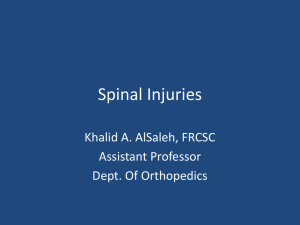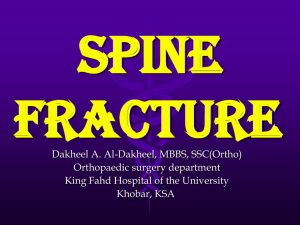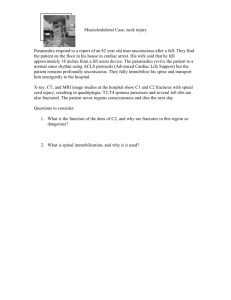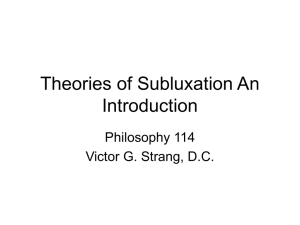Common adult fractures Axial skeleton (spine and pelvis)
advertisement
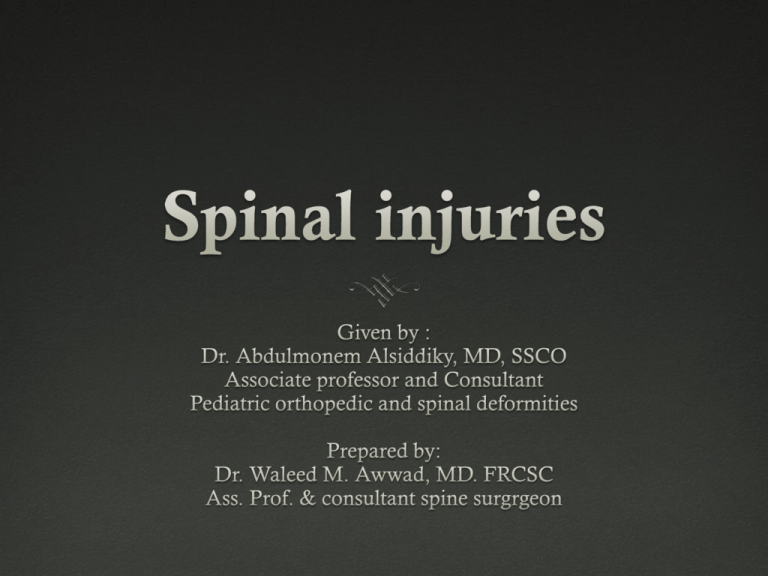
Objectives The ability to demonstrate knowledge of the following: Basic anatomy of the spine. Initial assessment and treatment of spinal injuries at the field. Principle of spinal stability. Understanding of neurologic syndromes caused by spinal trauma. Management of Cauda equina syndrome. Spine Pathology Red Flag Conditions Beware of: 1) Cauda Equina/severe neurologic injury (perianal numbness, decreased rectal tone, loss of movement in the extremeties). 2) Tumour weakening the vertebrae (causing cord compression or vertebral fracture). 3) Infection weakening bone (causing disc/vertebral destruction or cord compression). 4) Traumatic Spine Fracture (causing vertebral angulation, pain, or neuro compromise). Remember that spine fracture can occur without trauma. Anatomy Anatomy Anatomy Anatomy Anatomy Anatomy Anatomy Anatomy Anatomy Anatomy Anatomy Anatomy Anatomy Epidemiology 56000 cases per year. 11000 new spinal cord injuries. 15-20% multiple non-contiguous levels. 10% involving the cervical spine. 90% involving thoracolumbar spine. 25% have neurologic deficit. Age: mostly between 15-24 years. Gender: mostly males (4:1). Mechanism of Injury High energy trauma such as an MVA or fall from a height or a horse. MVA: 40-55% Falls: 20-30% Sports: 6-12% Others: 12-21% Low energy trauma in a high risk patient (ie a patient with known spinal canal compromise such as ankylosing spondylitis, Osteoporosis or metatstatic vertebral lesions) Penetrating trauma from gunshot or knives. Spine stability Cervical spine instability: Compression fracture with 25% loss of height. Angular displacement > 11 degrees. Translation > 3.5mm. Disc space separation >1.7mm. Thoracic and lumbar spine: Denis three column. The Three columns Instability exists with disruption of any two of three columns. Assessment In cases of trauma, ABCDE’s must be assessed first and treated appropriately. Patients should be examined with cervical collar until spinal pathology is excluded. Careful log rolling keeping the head, neck and pelvis in line should be done to examine the spine properly. Assessment Immobilization. History: Mechanism of injury: compression, flexion, extension, distraction Other injuries. Seat belt. Other causes. Physical examination: Inspection, palpation. Neurologic examination. Immobilization Neurologic Muscle Test Sensory exam light touch, Sharp dull discrimination, Vibration sense, Proprioception and two-point discrimination Reflexes Signs of Spinal Trauma Apnea, lower cranial nerve injury VIII-XII (high C-spine). Deformity of the spine or neck. Tenderness on palpation along spinal processes. Paralysis or muscle weakness (which spinal level). Loss of sensation (which dermatones). Loss of rectal tone. Positive Babinski sign. Asia Score: Brief Trauma Neurologic Survey Level of Cord Injury determines level of function Prognosis for Recovery of spinal Cord Injury: Poor prognosis for recovery if: -pt arrives in shock -pt cannot breath -pt has a complete injury Assessment Severity of neurologic deficit Complete Flaccid paralysis below level of injury. May involve diaphragm if injury above C5. Sympathetic tone loss if fracture above T6. Incomplete ? Any sensation. ? Sacral spairing. Assessment Severity of neurologic deficit Incomplete Central cord syndrome: # Characterized by disproportionally (UL>LL). # Mechanism: hyper-extension. # Occur with or without fractures. # Recovery: 50% regaining function. # Prognosis is fair. Assessment Severity of neurologic deficit Incomplete Anterior cord syndrome: # Characterized by loss of corticospinal and spinothalamic tract with preserved posterior column. # Mechanism: ischemia or infarction to spinal cord.. # Common injury. # Recovery: 10%. # Prognosis is good if progressive recovery within 24hrs, absent SS after 24hrs protends a poor outcome. Assessment Severity of neurologic deficit Incomplete Brown-Sequard syndrome: # Characterized by hemicord injury with ipsilateral paralysis, loss of proprioception and light touch, and contralateral temperature and sharp pain loss. # Prognosis is good, with over 90% regaining of bowel and bladder function and ambulatory capacity. Assessment Severity of neurologic deficit Incomplete Conus Medullaris syndrome: # Seen in T12-L1 injuries. # Loss of voluntary bowel and bladder control with preserved lumbar root function. # Uncommon as pure lesion (mixed conus-cauda). Assessment Severity of neurologic deficit Incomplete Cauda Equina syndrome: # Saddle anesthesia, urinary retention and stool incontinence. # Usually due to large central disc herniation rather than fracture. Nerve root deficit: LMN Spinal Shock Transient loss of spinal reflexes. Lasts 24-72 hours. Neurogenic shock Reduced tissue perfusion due to loss of sympathetic outflow and un-apposed vagal tone. Injury above T6 level. Peripheral vasodilatation (hypotension and bradycardia). Rx: fluid resuscitation and vasopressors. Imaging X-rays: Cervical: 3 views. AP, lateral and open mouth. Thoraco-lumbar: 2 views. AP & lateral. Flexion-Extension views. CT: best for bony anatomy. MRI: best to evaluate soft tissue. Management of Spinal Injuries Depends on: Level of injury. Degree and morphology of injury: STABILITY Presence of neurologic deficit. Other factors. Some general rules: Stable injuries are usually treated conservatively. Unstable injuries usually require surgery. Neurologic compression requires decompression. Specific Injuries Cervical spine fractures Descriptive: depends on mechanism of injury. Flexion/extension. Compression/distraction. Shear. Presence of subluxation/dislocation SCI: High level fracture results in quadriplegia. Low level fracture results in paraplegia. Cervical spine fractures Thoraco-Lumbar fractures Spinal cord terminates at L1/2 disc in adult L2/3 in a child 50% of injuries occur at Thoraco-lumbar junction. Common fractures: Wedge fracture (flexion/compression). Burst (compression). Chance (flexion/distraction). Wedge fracture Burst fracture Chance fracture Chance fracture Fracture dislocation Pathologic fractures Low-energy fractures. Osteoporotic is common. Usually due to infection or tumour. X-rays: “winking owl” sign. Pathologic fractures Cauda Equina Syndrome A surgical emergency. Requires full neurologic examination including rectal examination for anal tone. Investigations: X-rays initially, but MRI is mandatory as Xrays are usually unremarkable. Treatment: Emergency decompression-usually discectomy and wide laminectomy within 24 hours. Cauda Equina Causes Disc hernia Central disc prolapse. Burst fractures of lumbar spine. Penetrating injuries such as stab wounds or bullets. Epidural hematoma from spinal anesthesia, or post surgery(rare). Tumor Tumours compressing the lower spinal nerve roots. Spinal Stenosis. Bullet to cauda Burst fracture Cauda Equina Syndrome thanks

